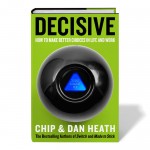Decisive: the anti-blinking guide to decision making

In their 2013 book Decisive, the Heath brothers argue that when it comes to decision-making, our brains are flawed instruments. Given that we are biologically hard-wired to be biased and irrational at times, their question was, how can we do better? The book starts by identifying the four villains of decision-making and then offers a way forward with the process they call WRAP.
FOUR VILLAINS OF DECISION MAKING:
- Narrow framing. We are guilty of “spotlight thinking.” We focus on the obvious and visible, based on our past experience. We miss important facts outside our narrow frame.
- Confirmation bias. We develop a quick belief about something and then seek out information that confirms that belief.
- Short-term emotion. We are too emotionally connected to the decision and struggle with being appropriately detached.
- Overconfidence. We assume that we know more than we actually do know and jump to conclusions, thinking we can accurately predict the future.
WRAP:
The great value of the book is that it lays out a decision-making process that can be used in any situation. It is designed to counteract the influence of the four villains and consists of four steps:
- Widen your options. Too often we turn decisions into either/or choices, which automatically shuts down the spotlight of our attention and closes out other options.
- Reality-test your assumptions. To overcome our confirmation bias, we are encouraged to consider the opposite, ask open questions, and zoom out to get a baseline.
- Attain distance before deciding. To reduce the impact of emotions, take time before deciding. Another technique is to consider the decision as if it were someone else’s.
- Prepare to be wrong. The future isn’t a point, but a range. Consider the potential outcomes of the decision, from worst to best. Set a “tripwire” that if its hit, will be a clue that the decision was wrong before you are too far in to turn back.
In Blink, Gladwell makes the case for the ability of the brain to learn more and make connections faster than we are consciously aware of. Remember being told to “go with your first instinct” and to “listen to your gut”? In Decisive, the Heaths caution against “thinking without thinking” and are in favor of reasoned decision making. Both use neuroscience research and compelling anecdotes to underscore their arguments. In the end, it really comes down to the fact that both can be true. What’s good about Decisive is that it offers a practical way to put your intuition to the test when the stakes are high.
Comments
One Response to “Decisive: the anti-blinking guide to decision making”
Leave a Reply

If you move out from Central to lower cost industrial areas, be paeerrpd to lose some of your staff as well. A lot of OL take pride working in Central. This is a symbol of status.